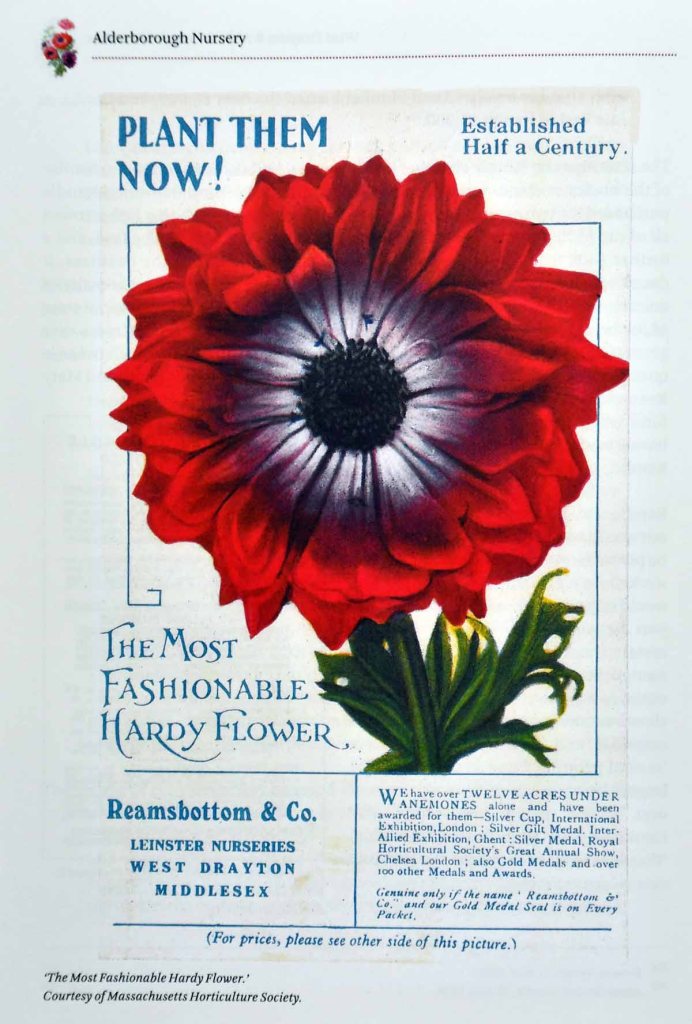Alderborough Nursery
This book is a wonderful testimony to the esteem in which we hold beautiful plants, gardening and horticulture here in Ireland. More especially, it recalls the central part one family nursery played in the life of an Irish community so that it became part of its social history, a part now fondly and proudly recalled in this volume.
William Reamsbottom began his career in Preston with a florist’s shop and soon realised that mail order was a far better business model. The polluted air of industrial Britain was not conducive to good health so he returned to Ireland and set up in Twickenham House, Ballycumber, County Offaly – “King’s County”, as it was known then – growing and supplying lavenders, sweetbriars and begonias by mail order. He married Mary Enraght Moony of The Doon, Ballinahown and they moved to Alderborough House, Geashill, to set up home and business in 1890. The land was good, there was an excellent local supply of labour, the postal service was efficient and the nearby train station facilitated transportation of plants, tubers etc around Ireland, to Britain, the continent and soon around the world. It was an extraordinary success story.

Central to the nursery’s success was the development of the Alderborough strain of anemones. A Mrs. Lawrenson of Co. Kildare and of Sutton House in Howth, Co. Dublin had developed the St. Brigid strain of the Poppy Anemone, Anemone coronaria, which were very popular and are still popular to this day. Mary Enraght Moony’s grandfather, George Maunsell of Ballywilliam, Co. Limerick, had also produced a very attractive anemone by crossing Anemone coronaria with Anemone hortensis and this was brought to The Doon, on marriage, by his daughter. William spotted the attractive flowers when visiting and brought plants back with him to Alderborough. Through continuous selection of seedlings he improved the strain and scaled up its production and eventually supplied it worldwide. In 1902 the Royal Horticultural Society’s judges granted the Alderborough Anemone its “Award of Merit” and reported, “This strain is remarkable for the unusually large double and semi-double flowers in such varied colours from white through shades of pink, rose, scarlet and crimson to purple and violet.” The business was a great success and lead to nurseries at West Drayton, England, and at Streamstown, Co. Westmeath.

In a way, that is the story summarised in a few sentences but you must read the book to grasp and be amazed at the full story of Alderborough Nursery. If William and Mary Reamsbottom were in business today we would be in awe at the volume of plants they produced, at the number of gardening shows they attended, at the standard and vast numbers of plants they transported to these shows, at the huge number of awards they achieved and this was an achievement of a century ago, without the benefits of air transport, nor of refrigerated units to transport plants, nor the ease of communication we have today. It is truly a remarkable story and wonderfully recorded by authors Anne & Tim O’Rourke. The amount of original material used throughout the book – newspaper advertisements, show reports, newspaper reports, magazine articles, catalogue covers and listings etc – gives a wonderful insight into both the story of Alderbourough and the other nurseries and into the social situation and social changes at the time.
At the heart of this story is the simple love of growing plants but this book goes far beyond that and gives us an extraordinary insight into what life was like in Ireland a century ago, into day to day ordinary life and into society in general. It is a great achievement for the authors and, I believe, a treasure for their community – and, for us, a pleasure to read.

[Alderborough Nursery, Geashill, Offaly. Reamsbottom & Co., Geashill and West Drayton & Alderborough St. Brigid Anemones, Anne & Tim O’Rourke, 2022, Softback, 283 pages, €20, ISBN: 978-1-9163287-5-4 This book was published with the assistance of Offaly County Council and the Creative Ireland Programme and is available from Offaly History online bookshop, http://www.offalyhistory.com/ ; Midland Books, Tullamore; Gorman’s shop, Killeigh; Byrnes shop, Geashill and Birr Castle shop.]

